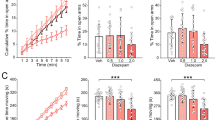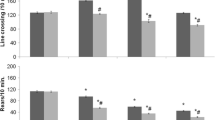Abstract
In exploratory animal models of anxiety, such as the elevated plus maze, the anxiogenic- and anxiolytic-like effects of drugs may be confounded by changes in locomotor activity. In the present experiments, the sensitivity of several measures of anxiety and locomotor activity in the elevated plus maze were assessed. Both chlordiazepoxide hydrochloride (CDP, 7.5 mg/kg) andd-amphetamine sulphate (AMP, 0.75, 1.5 mg/kg) increased the percent time on the open arms and doses of 7.5 mg/kg and 1.5 mg/kg CDP and AMP, respectively, increased the number of entries into the open arms. The increase in these measures might suggest that both compounds induced an anxiolytic-like effect. Although FG 7142 (30.0 mg/kg) did not decrease the number of entries to the open arms, it did decrease the time on the open arms, which might suggest that it had anxiogenic-like effects. Similarly, buspirone reduced both the number of entries into the open arms and the time spent on the open arms. However, all the compounds significantly affected locomotor activity. CDP (3.0 and 7.5 mg/kg) increased the total number of arm entries, the distance travelled on the open arms and the mean speed of the animals on the open, and in the closed arms. Moreover, the distance travelled by the animals in the closed arms was increased by 1.0 mg/kg CDP, a dose that had no measurable effects on the indices of anxiety. Similarly, although AMP failed to increase the total number of arm entries, it did increase the distance travelled in the closed arms (0.75 and 1.5 mg/kg), on the open arms (1.5 mg/kg) and the speed of the animals in the closed arms (1.5 mg/kg), a measure that is independent of the time spent in the closed arms. By contrast, both FG 7142 (30.0 mg/kg) and buspirone decreased the total number of arm entries (0.3–8.0 mg/kg), the speed of the animals in the closed arms and the distance travelled in the closed arms (1.0–4.0 mg/kg). These experiments suggest that: (i) the anxiogenic- and anxiolytic-like effects of drugs in the elevated plus-maze are confounded by changes in locomotor activity and that “total arm entries” is a relatively insensitive measure of drug-induced changes in locmotor activity; (ii) psychostimulant compounds, such as AMP, at doses that increase locomotor activity have an anxiolytic-like profile in the elevated plus maze and (iii) the measurement of speed of movement is a more sensitive index of changes in locmotor activity than the conventional measure of “total arm entries”.
Similar content being viewed by others
References
Cole JC, Rodgers RJ (1994) Ethological evaluation of the effects of acute and chronic buspirone treatment in the murine elevated plus-maze test: comparison with haloperidol. Psychopharmacology 114:288–296
Costall B, Kelly ME, Tomkins DM (1989) Use of the elevated plus maze to access anxiolytic potential in the rat. Br J Pharmacol 96:312P
Dawson GR, Crawford SP, Stanhope JK, Iversen SD, Tricklebank MD (1994) One-trial tolerance to the effects of chlordiazepoxide on the elevated plus maze may be due to locomotor habituation, not repeated drug exposure. Psychopharmacology 113:570–572
File SE (1991) The biological basis of anxiety. In: Meltzer HY, Nerozzi D, (eds) Current practices and future developments in the pharmacotherapy of mental disorders. Elsevier, Amesterdam, pp 159–165
Handley SL, McBlane JW (1993) An assessment of the elevated X-maze for studying anxiety and anxiety-modulating drugs. J. Pharmacol Toxicol Methods 29:129–138
Kaiser FC, Palmer GC, Wallace AV, Carr RD, Fraser RL, Hallam C (1992) Antianxiety properties of the angiotensin II antagonist, DUP 753, in the rat using the elevated plus-maze. Neuroreport 3:922–924
Killcross AS, Dickinson A, Robbins TW (1994) Amphetamine-induced disruptions of latent inhibition are reinforcer mediated: implications for animal models of schizophrenic attentional dysfunction. Psychopharmacology 115:185–195
Lister RG (1987) The use of a plus-maze to measure anxiety in the mouse. Psychopharmacology 92:180–185
Lister RG (1991) Ethologically based animal models of anxiety disorders. In: File SE (ed) Psychopharmacology of anxiolytics and antidepressants. Pergamon New York, pp 155–185
Luscombe GP, Mazurkiewicz SE, Heal DJ (1992) The 5HT1A ligands BP 554 mimics the anxiolytic activity of buspirone, geprione and ipsapirone in the elevated plus maze in rats. Br J Pharmacol 105:221P
Moser PC (1989) An evaluation of the elevated plus-maze using the novel anxiolytic buspirone. Psychopharmacology 99:48–53
Moser PC, Hibert M, Mirk AK, Tricklebank MD, Fosard JR (1988) Effects of MDL 73005EF in animal models predictive of anxiolytic activity. Br J Pharmacol 93:3P
Pellow S, File SE (1986) Anxiolytic and anxiogenic drug effects on exploratory activity in an elevated plus maze: a novel test of anxiety in the rat. Pharmacol Biochem and Behav 24:525–529
Pellow S, Chopin P, File SE, Briley M (1985) Validation of open: closed arm entries in an elevated plus-maze as a measure of anxiety in the rat. J Neurosci Methods 14:149–167
Pellow S, Johnston, AL, File SE (1987) Selective agonists and antagonists for 5-hydroxytryptamine receptor subtypes, and interactions with yohimbine and FG 7142 using the elevated plus-maze test in the rat. J Pharm Pharmacol. 39:917–928
Robbins TW, Iversen SD (1973) A dissociation of the effects ofd-amphetamine on locomotor activity and exploration in rats. Psychopharmacologia 28:155–164
Ryan CN, Evenden JL, Petterson M (1993) Effects of buspirone and ipsapirone on schedule induced polydipsia: comparison with 8-hydroxy-2-(di-n-propylamino)tetralin (8-OH-DPAT) and raclopride. Psychopharmacology 112:34–44
Söderpalm B, Hjörth S, Engel JA (1989) Effects of 5-HT1Areceptor agonists andl-5HTP in Montgomery's conflict test. Pharmacol Biochem Behav 32:259–265
Thiébot MH, Soubrié P, Sanger D (1988) Anxiogenic properties of beta-CCE and FG 7142: a review of promises and pitfalls. Psychopharmacology 94:452–463
Triet D (1985) Animal models for the study of anti-anxiety agents: a review. Neurosci Biobehav Rev 9:203–222
Triet D (1991) Anxiolytic effects of benzodiazepines and 5-HT1A agonists: animal models. In: Rodgers RJ, Cooper SJ (eds) 5-HT1A agonists 5-HT3 antagonists and benzodiazepines. Wiley, UK
Author information
Authors and Affiliations
Additional information
All the experiments reported in this manuscript were conducted within British Government Home Office approved techniques, procedures and project licences.
Rights and permissions
About this article
Cite this article
Dawson, G.R., Crawford, S.P., Collinson, N. et al. Evidence that the anxiolytic-like effects of chlordiazepoxide on the elevated plus maze are confounded by increases in locomotor activity. Psychopharmacology 118, 316–323 (1995). https://doi.org/10.1007/BF02245961
Received:
Revised:
Issue Date:
DOI: https://doi.org/10.1007/BF02245961




